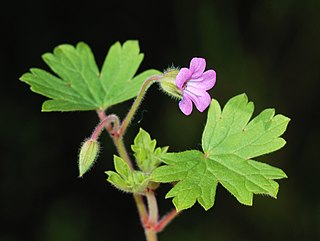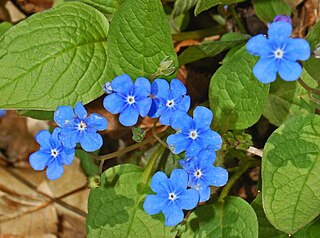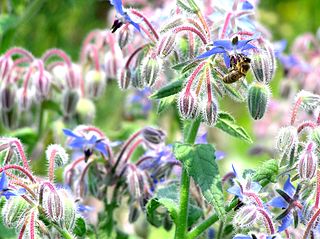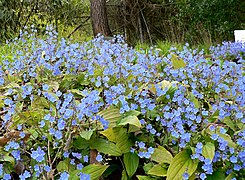
Boraginaceae, the borage or forget-me-notfamily, includes about 2,000 species of shrubs, trees, and herbs in 146 to 154 genera with a worldwide distribution.

Geraniaceae is a family of flowering plants placed in the order Geraniales. The family name is derived from the genus Geranium. The family includes both the genus Geranium and the garden plants called geraniums, which modern botany classifies as genus Pelargonium, along with other related genera.

Alstroemeriaceae is a family of flowering plants, with 254 known species in four genera, almost entirely native to the Americas, from Central America to southern South America. One species of Luzuriaga occurs in New Zealand, and the genus Drymophila is endemic to south-eastern Australia.

Colchicaceae is a family of flowering plants that includes 15 genera with a total of about 285 known species according to Christenhusz and Byng in 2016.

Pulmonaria (lungwort) is a genus of flowering plants in the family Boraginaceae, native to Europe and western Asia, with one species east to central Asia. According to various estimates there may be between 10 and 18 species found in the wild.

Boraginales is an order of flowering plants in the asterid clade, with a total of about 125 genera and 2,700 species. Different taxonomic treatments either include only a single family, the Boraginaceae, or divide it into up to eleven families. Its herbs, shrubs, trees and lianas (vines) have a worldwide distribution.

Omphalodes verna, the creeping navelwort or blue-eyed-Mary, is a rhizomatous herbaceous perennial plant in the genus Omphalodes belonging to the family Boraginaceae.

Myosotidium is a genus of plants belonging to the family Boraginaceae. This genus is represented by the single species Myosotidium hortensia, the Chatham Islands lily, giant forget-me-not or Chatham Islands forget-me-not, which is endemic to the Chatham Islands, New Zealand. In the Māori language, it is known by the name kopukapuka.

Boraginoideae is a subfamily of the plant family Boraginaceae s.s, with about 42 genera. That family is defined in a much broader sense in the Angiosperm Phylogeny Group (APG) system of classification for flowering plants. The APG has not specified any subfamilial structure within Boraginaceae s.l.

Codon is a small genus of plants from South Africa in the family Codonaceae in the order Boraginales. The genus Codon comprises two species.

Pseudomertensia is a genus of flowering plants in the family Boraginaceae. They are perennial herbs with blue or bluish purple flowers. Their natural range is from Iran to the Himalayas. None have been found in China or Russia. P. echioides, and the type species for the genus, P. elongata, are occasionally cultivated as ornamentals.
Mimophytum is a genus of flowering plants in the family Boraginaceae. The species occur in Northeastern Mexico and adjacent areas of Texas, United States. They are similar to the closely related genus Omphalodes but a distinct group.
Selkirkia is a genus of flowering plants in the family Boraginaceae. Three species occur on the South American mainland and one, Selkirkia berteroi, the first of the genus to be reported, is an endemic on Robinson Crusoe Island off the coast of Chile. It was previously considered a monotypic genus.

Carlos Adolfo Lehnebach is a New Zealand botanist. He is employed as a botany curator at the Museum of New Zealand Te Papa Tongarewa. Lehnebach has a master's degree and a PhD from Massey University.

Andersonglossum boreale, known as northern wild comfrey or just wild comfrey, is a species of flowering plant in the borage family, Boraginaceae. It is native to boreal coniferous and mixed forests in North America, from Nova Scotia to British Columbia and Yukon in Canada, south to New Jersey and Indiana in the United States. It is often found in rocky or sandy soils. It is extirpated from many of the southern parts of its range.

Iberodes is a genus of flowering plants in the family Boraginaceae native to southwest Europe. The whiteflower navelwort is part of this genus. Most specimens are from the Iberian Peninsula. The genus was previously thought to be part of Omphalodes, and in 2016 was moved to its own. Iberodes kuzinskyana was assessed as Vulnerable in 2010 and is now assessed as Critically endangered by the Portuguese Botanical Society.
Memoremea scorpioides is a species of flowering plant belonging to the family Boraginaceae. It is the sole species in genus Memoremea. Its native range is eastern-central and eastern Europe.

Huynhia is a genus of flowering plants belonging to the family Boraginaceae, from Asia.
Nihon is a genus of flowering plants in the family Boraginaceae. It includes five species native to Japan and Korea.

















